The Longest of Trails
From Texas to Canada
One of the lesser romanticized cattle driving trails of the 1800’s actually stretched all the way from the Rio Grande in south Texas to the Canadian border. The trail was known as the Great Western Trail and often referred to as the Texas Trail. This trail which eventually spanned the entire north to south length of the U.S. was the busiest of all for cattle drives.
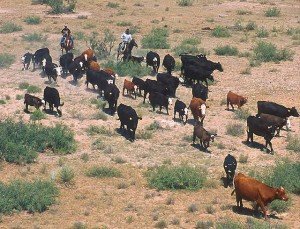
Two of the more publicized cattle drive trails, aside from the Western Trail or the Texas Trail were the Chisholm Trail and the Goodnight-Loving Trail. The Chisholm Trail led from the south Texas ranches up through what is now east central Texas, through Fort Worth and Indian Territory, to the railroad towns in Kansas. The Goodnight-Loving Trail was a route far to the west running into New Mexico near Fort Sumner and then northward toward Colorado. The movie Lonesome Dove was based loosely on the exploits of Texas rancher Charles Goodnight, known as the Father of the Texas Panhandle, and his trail blazing partner Oliver Loving.
Most history books attribute the blazing of The Great Western Trail to a man named John T. Lytle who drove a herd of 3,500 head of cattle through Texas in 1874. In Texas this trail was sometimes referred to as the Fort Griffin Trail or the Dodge City Trail. Further to the north it was called by many the Texas Trail. The Great Western Trail ran in the same general direction as the Chisholm Trail, only more to the west. In south Texas, the trail head was near Bandera Texas just a short distance northwest of San Antonio. Several feeder trails from the lower Rio Grande Valley led to Bandera. Because of this, the Western Trail or the Texas Trail could be said to reach all the way down to the Rio Grande. Today, Bandera Texas calls itself “The Cowboy Capital of the World”.
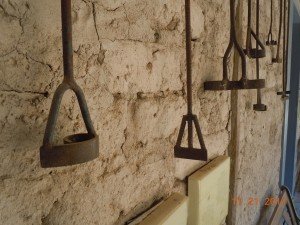
Running through Texas, the trail passed by Buffalo Gap just west of Abilene, past Fort Griffin and nearby to present day Vernon Texas near the Oklahoma border. Looking at a present day map of Texas, the Great Western Trail roughly followed today’s US Hwy 83 and US Hwy 283 up from south Texas to the Red River. The crossing of the Red River and into what was then Indian Territory was made at a small settlement called Doan’s Crossing which was established in 1878.
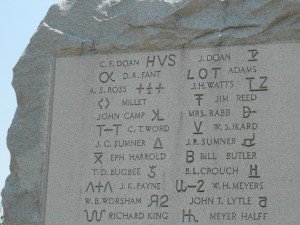
Historic Doan’s Crossing
Doan’s Crossing is about eighteen miles north of Vernon Texas on the Red River.
Doan’s Crossing today is a ghost town but back in the late 1870’s it was anything but that. Doan’s Crossing was called the “jumping off place” and the last settlement with stores before you traveled into Indian Territory on your way to Dodge City Kansas.
At it’s peak, Doan’s Crossing had about 300 inhabitants. You can just imagine how busy it was during the cattle drives. The Doan’s General Store was a hub of activity. According to the Red River Museum in Vernon Texas, some 6 million cattle and 1 million horses passed through Texas, Doan’s Crossing and through Indian Territory on the Great Western Trail.
An interesting tourist item is that a Doan’s Crossing Celebration and Picnic is held annually. This event starts on the Texas side of the Red River and features over one hundred riders. The annual Picnic event has been celebrated continuously for 136 years. This is remarkable in itself. Direct descendants of the Doan’s Crossing pioneers are crowned King and Queen during the event. The public is invited to attend this fun and historic event. If you’re traveling near Vernon Texas at the time of the celebration, it could be a very unique addition to your trip planner. My information is that the event usually takes place in May.

Destination Dodge City and Beyond
The Great Western Trail’s first destination was the roaring cowtown of Dodge City Kansas. This was the western end of the rail line and was an ideal location for the Texas herds. As it turned out, Dodge City would remain the western terminus for some time since the financial panic of 1873 put a halt on rail construction further west. At least for the time being. The railroad and the Texas Longhorn cattle put Dodge City on the map and turned it into the legendary cattle town it was. The stories of Wyatt Earp, Doc Holliday, Bat Masterson and others all evolved from the cow town days of Dodge City Kansas.
Many events were taking place on the northern plains at about this same time during the mid 1870’s. The Sioux and Cheyenne tribes north of the Platte River were roaming free hunting buffalo. The U.S. government was making every effort to return these Native Americans to reservations. Gold was discovered in the Black Hills of the Dakota Territory and settlers and miners were flooding into the region.
Treaties between the U.S. and the Native Americans were being broken by both sides. The federal government could not have held back the flood of emigrants even if it really wanted to. All of this came together in what ended up to be the Great Sioux War of 1876-77. This conflict came to a head when Custer was defeated at the Battle of the Little Bighorn and the army launched an all out campaign to round up the free roaming Indians once and for all. The military committed massive forces after the Little Bighorn battle to achieve this end.
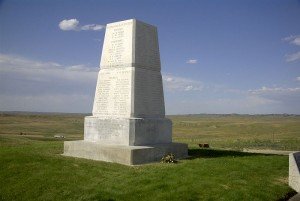
Into the Land of the Sioux
The excellent grazing potential of the Powder River region of Montana and surrounding areas was not lost on the ranchers. What hampered grazing of their cattle in the northern plains was the Indian problem and now the issue was coming to a head. What cattle that was being grazed in Montana had been driven east from Oregon. When the Sioux War ended with the surrender of Crazy Horse in 1877 and the return to the Red Cloud Agency of his followers, the northern plains opened up.
In the book, Trailing the Longhorns by author Sue Flanagan, the following move into the Powder River region is described. “As the Sioux retreated to reservations in 1877-1878, trail herds streamed into this valley stretching from Wyoming to Montana. The coveted grasslands were reached by a drive of three months and twenty days up from the Red River boundary with Texas. Many cowboys stayed on this northern range to work as hands or to establish ranches“. The booming Montana mining towns such as Virginia City were good end markets for cattlemen.
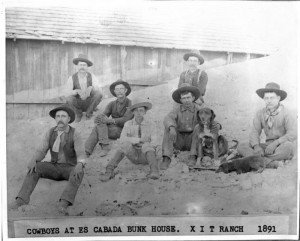
The Trails of the Northern Plains
As the Indians of the northern plains retreated to their reservations in 1877 and 1878, the cattlemen pushed northward. In just a few years after the opening of the northern plains, Texas cattle brands such as the famous XIT were seen in Wyoming and Montana. The XIT leased 2 million acres of grazing land between the Yellowstone and the Missouri Rivers. The XIT drove 10,000 head of young steers from the Texas Panhandle all the way to Montana.
The Great Western Trail spread northward into Wyoming, Montana and the Dakotas. In these areas it was generally called the Texas Trail. Similar to other cattle drive trails, there were several feeder trails branching out. The trails were anything but one long road. depending on the northern markets to be served and the location of rail heads, feeder trails ran all over the northern plains. One thing that the cattle drovers did find in the north plains was a different climate. Unlike the plains of Texas, when you grazed north of the North Platte River, winter could come early. Sue Flanagan in Trailing the Longhorns writes…”Late August and early September snows , not uncommon from the North Platte in Wyoming to Montana and beyond, were revelations to sun-baked Texans arriving with cattle”. She goes on to reflect on how the Texas Trail, which the Great Western Trail was called in many areas of the north, paralleled the Deadwood Stage route for many miles in Wyoming and passed by the Cheyenne-Deadwood stage station. “Stage stops were welcome sights when cow ponies needed shoeing or chuck wagon axles broke. Like the forts, some stage stations had telegraph facilities, which drovers used more and more to contact their markets and home ranches”.
The Railroad Brought the Markets Closer to the Herds
Cattle drives in the north were much shorter than the old Texas to Kansas route. In the north the cattle were much closer to their market. Both the Union Pacific Railroad and the Northern Pacific were at most only two days away. One very active cattle town was Ogallala in Nebraska and directly on the Union Pacific rail line. Today, the town is off Interstate 80. The town’s name was derived from the Sioux tribe. The word in Sioux language means to scatter or scatter ones own. This was very appropriate for this cattle town because from it’s location on the Union Pacific route, trails were spread to the north in many directions. To give you an idea of the kind of cattle traffic seen at Ogallala, the book Trails of the Longhorns points out that in 1876, the record number of cattle driven by one firm, (Ellison, Dewees, Millett and Mabry) into Ogallala was 100,000. In addition to that, it was reported that the King Ranch of south Texas drove some 30,000 head of cattle to Ogallala that very same year. This kind of cattle traffic occurred in a town that never had a permanent population of over one-hundred. What it did have was a coveted rail head.
Links to additional Trips Into History articles you’ll enjoy are the Surrender of Crazy Horse...Cattle Drives and the Cowboy Life and Sitting Bull and Buffalo Bill Cody.
The Red Cloud Agency
In addition to the rail heads of the Union Pacific and Northern Pacific Railroads, there was a regular market right at the cattlemen’s doorstep. One offshoot trail from the Great Western or the Texas Trail, was a road to the Red Cloud Agency which housed many of the Sioux who had retreated just a short time before.
The cattle upon arrival would be put in pens at the Red Cloud Agency and Indian names would be called out for each to claim his steer. To give you a perspective of the size of the Indian beef market, it was reported that in the year 1880, the Sioux-beef contracts exceeded 39 million pounds. In addition to this, the cattlemen regularly supplied beef to the military posts in the north. The end market for much northern beef was not far from the grazing lands and this helped make cattle ranching even more profitable.
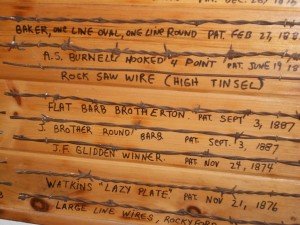
Barbed Wire and the End of the Great Cattle Drives
In a large way, the increased settlement in the great plains spelled the end of the open range and the great cattle drives. Settlers arrived and in many cases erected barbed wire fences around their land. Cattlemen had to share the open range with farmers. This was a first. They also shared the grasslands with sheep.
Times were changing dramatically. There was more than one skirmish between cattle interests and the agrarians. Probably the most violent and infamous conflict was the Johnson County War in Wyoming. After lynchings, shootings and a counterattack by settlers from the town of Buffalo Wyoming, U.S. troops reluctantly entered the fray. The violence was stopped, many gunmen working for the cattlemen were arrested but eventually none were successfully prosecuted. The Johnson County War showed just how high the friction was between cattlemen and settlers.
The Last Great Cattle Drive
The last great cattle drive up from Texas occurred in 1893 with a herd headed for Deadwood South Dakota. Rail heads were expanding and the distance to markets decreased substantially. The romanticized American ranching industry was changing at the turn of the century and would never be the same. What would live on forever was it’s colorful history.The history of cattle drives, the cowboys and the trails they used is quite interesting and of course there’s many side stories on the subject to explore further.
Recommended reading include Trailing the Longhorns by author Sue Flanagan…The Cattle Kings by author Lewis Atherton and Dodge City:The Cowboy Capital by author Robert M. Wright.
(Cattle branding irons, Doan’s Crossing monument, barbed wire exhibit from author’s collection. Remaining photos from the public domain)
